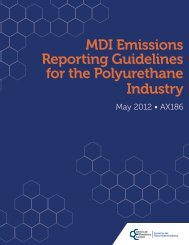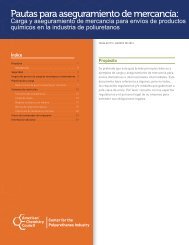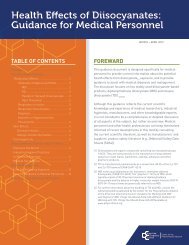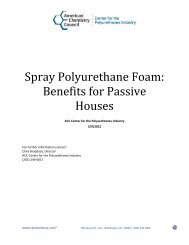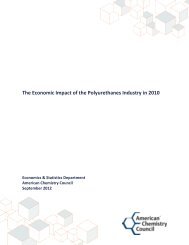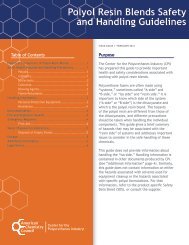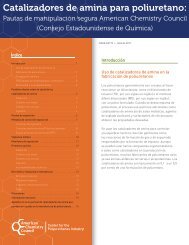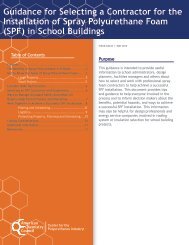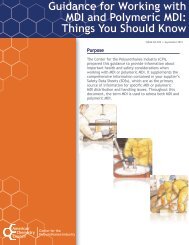Health Effects of Diisocyanates: Guidance for Medical Personnel
Health Effects of Diisocyanates: Guidance for Medical Personnel
Health Effects of Diisocyanates: Guidance for Medical Personnel
You also want an ePaper? Increase the reach of your titles
YUMPU automatically turns print PDFs into web optimized ePapers that Google loves.
<strong>Health</strong> <strong>Effects</strong> <strong>of</strong> <strong>Diisocyanates</strong>:<br />
<strong>Guidance</strong> <strong>for</strong> <strong>Medical</strong> <strong>Personnel</strong><br />
TABLE OF CONTENTS<br />
Foreward ......................................................... 1<br />
Potential <strong>Health</strong> Hazards ............................... 2<br />
Respiratory <strong>Effects</strong> ..................................... 2<br />
Inhalation <strong>of</strong> Vapors and Mists .............. 2<br />
MDI .................................................... 2<br />
TDI ..................................................... 2<br />
Heated or Sprayed <strong>Diisocyanates</strong> ..... 2<br />
Odor Threshold ................................. 2<br />
Respiratory Irritation ............................. 3<br />
Respiratory Sensitization ....................... 3<br />
Diagnosis ............................................... 3<br />
Alveolitis or Hypersensitivity<br />
Pneumonitis ........................................... 4<br />
Skin <strong>Effects</strong> .................................................. 4<br />
Dermal Irritation ..................................... 4<br />
Allergic Contact Dermatitis .................... 4<br />
Carcinogenicity ............................................ 5<br />
Ways to Address Potential <strong>Health</strong> <strong>Effects</strong> ...... 6<br />
Exposure Guidelines .................................... 6<br />
Industrial Hygiene Practices<br />
to Minimize Exposure .................................. 6<br />
<strong>Medical</strong> Surveillance ................................... 7<br />
<strong>Medical</strong> Management ..................................... 8<br />
First Aid Following Exposure ....................... 8<br />
Note <strong>for</strong> <strong>Guidance</strong> to <strong>Medical</strong> <strong>Personnel</strong> ..... 8<br />
References and Additional In<strong>for</strong>mation .......... 9<br />
FOREWARD<br />
(AX150) • APRIL 2013<br />
This guidance document is designed specifically <strong>for</strong> medical<br />
personnel to provide current in<strong>for</strong>mation about the potential<br />
health effects from diisocyanate (1) exposure, and to provide<br />
guidance to assist with medical diagnosis and management.<br />
The discussion focuses on two widely used diisocyanate-based<br />
products: diphenylmethane diisocyanate (MDI) and toluene<br />
diisocyanate (TDI) (2)(3)(4).<br />
Although this guidance reflects the current scientific<br />
knowledge and experience <strong>of</strong> medical researchers, industrial<br />
hygienists, manufacturers, and other knowledgeable experts,<br />
it is not intended to be a comprehensive or detailed discussion<br />
<strong>of</strong> all aspects <strong>of</strong> the subject, but rather an overview. <strong>Medical</strong><br />
personnel and other health pr<strong>of</strong>essionals can keep themselves<br />
in<strong>for</strong>med <strong>of</strong> recent developments in this field by consulting<br />
the current scientific literature, as well as manufacturers’ and<br />
suppliers’ product safety literature (e.g., (Material) Safety Data<br />
Sheets (SDSs)).<br />
(1) <strong>Diisocyanates</strong> are organic compounds containing two isocyanate groups<br />
(-NCO). They are used primarily in the manufacture <strong>of</strong> polyurethane<br />
systems to make foams, elastomers, coatings, adhesives and other<br />
polymeric products.<br />
(2) TDI is manufactured predominantly as a mixed ratio, 80:20, <strong>of</strong> the 2,4-TDI<br />
and 2,6-TDI isomers (CAS# 26471-62-5).<br />
(3) MDI is the usual abbreviation <strong>for</strong> monomeric methylene diphenyl<br />
diisocyanate, (CAS# 101-68-8). The “polymeric” <strong>for</strong>ms <strong>of</strong> MDI, which<br />
typically consist <strong>of</strong> 30-70 percent monomeric diphenylmethane<br />
diisocyanate and the balance in higher molecular weight fractions (CAS #<br />
5873-54-1) may at times be generically referred to as MDI.<br />
(4) For further in<strong>for</strong>mation about the handling <strong>of</strong> TDI and MDI, consult the<br />
following bulletins published by the Center <strong>for</strong> the Polyurethanes Industry<br />
<strong>of</strong> the American Chemistry Council: <strong>Guidance</strong> <strong>for</strong> Working with MDI<br />
and Polymeric MDI: Things You Should Know (AX-205) and <strong>Guidance</strong> <strong>for</strong><br />
Working with TDI: Things You Should Know (AX-202) available at<br />
www.polyurethane.org.
2<br />
Center <strong>for</strong> the<br />
Polyurethanes Industry<br />
POTENTIAL HEALTH HAZARDS<br />
RESPIRATORY EFFECTS<br />
The predominant health effect <strong>of</strong> MDI and TDI is on the respiratory tract.<br />
Both chemicals have been shown to be portal-<strong>of</strong>-entry toxicants.<br />
INHALATION OF VAPORS AND MISTS<br />
MDI:<br />
At room temperature, MDI has a relatively low vapor pressure in comparison to other<br />
organic chemicals. The vapor pressure <strong>of</strong> MDI largely explains the very low to nondetectable<br />
airborne concentrations found during most applications. Studies show that<br />
airborne concentrations <strong>of</strong> MDI are associated only with processes or applications that<br />
involve heating (well above 100 degrees F) and/or spraying (aerosolizing).<br />
TDI:<br />
The vapor pressure <strong>of</strong> TDI is higher than MDI and at a typical room temperature<br />
(i.e., 70°F) the concentration <strong>of</strong> vapor in the air can exceed the OSHA Permissible<br />
Exposure Limit (PEL) <strong>of</strong> 20 ppb. Thus protective measures, including the use <strong>of</strong><br />
engineering controls (e.g., local exhaust ventilation), appropriate personal protective<br />
equipment (e.g., respiratory protection) or other workplace practices (e.g., proper<br />
handling and storage), etc., are taken whenever there is potential exposure to<br />
(unknown) airborne concentrations <strong>of</strong> TDI.<br />
Heated or Sprayed <strong>Diisocyanates</strong>:<br />
Exposure to heated diisocyanates can be extremely hazardous, not only because<br />
high vapor concentrations are <strong>for</strong>med, but also because condensation may result in<br />
airborne particulate, which may injure the eyes, skin, and respiratory tract. Similarly,<br />
spray mists can impose a significant health hazard.<br />
Odor Threshold:<br />
Reported odor threshold values <strong>for</strong> chemicals <strong>of</strong>ten are expressed in wide ranges<br />
because “odor” threshold testing has historically lacked a consistent approach.<br />
The reasons <strong>for</strong> the variation in reported odor thresholds include the chemical purity,<br />
the mode <strong>of</strong> presentation <strong>of</strong> the challenge agent to the individual, the influence <strong>of</strong><br />
extraneous factors in how the odor is introduced, and the type <strong>of</strong> observer used<br />
(i.e., age, gender, race).
Two studies on the odor threshold <strong>for</strong> MDI and TDI, respectively, are summarized below:<br />
• MDI: There is no reliable odor threshold <strong>for</strong> MDI reported. Nevertheless, the reported value <strong>of</strong> 0.4 ppm<br />
(400 ppb) suggests that if MDI is detected by smell, overexposure is likely to have occurred (Woolrich, 1982).<br />
• TDI: In one study (Henschler et al., 1962), recognition <strong>of</strong> the odor <strong>of</strong> TDI was achieved by 90% <strong>of</strong> the panel <strong>of</strong><br />
volunteers at 0.05 ppm (50 ppb) TDI. Thus, if TDI is detected by odor, most likely overexposure has occurred.<br />
RESPIRATORY IRRITATION<br />
The reactivity <strong>of</strong> the diisocyanates with the respiratory tract can cause irritation and inflammation at high<br />
concentrations. Irritating substances cause a decrease in respiratory rate in mice and rats. The RD 50 (50%<br />
reduction in respiration rate) <strong>of</strong> MDI is 32 mg/m 3 in mice (Weyel and Schaffer, 1985) and the RD 50 <strong>of</strong> TDI is<br />
1.4 mg/m 3 (0.2ppm) in mice (Sangha and Alarie, 1979).<br />
RESPIRATORY SENSITIZATION<br />
Respiratory sensitization results in hyperreactivity <strong>of</strong> the airways following inhalation <strong>of</strong> an allergen. Sensitization<br />
includes two phases: the first phase is induction <strong>of</strong> specialized immunological memory in an individual by<br />
exposure to an allergen. The second phase is elicitation, i.e., production <strong>of</strong> a cell-mediated or antibody-mediated<br />
allergic response by exposure <strong>of</strong> a sensitized individual to an allergen. There are several substances in the<br />
workplace, including diisocyanates, which can cause respiratory sensitization. One <strong>of</strong> the outcomes <strong>of</strong> respiratory<br />
sensitization can be occupational asthma.<br />
MDI and TDI-related occupational asthma can occur from overexposure in the workplace. <strong>Diisocyanates</strong> have<br />
been shown to cause bronchial reactivity <strong>of</strong> the respiratory tract, manifesting as wheezing, shortness <strong>of</strong> breath,<br />
and chest tightness in previously sensitized persons. These symptoms may occur either immediately or 6 to<br />
8 hours post exposure. Dual reactions involving both immediate and delayed reactions, have been reported.<br />
Follow up studies have demonstrated that if diisocyanate-related asthma is diagnosed early and the affected<br />
person avoids any further exposure, recovery can be complete (Tarlo, 1997; Pisati, 2007). However, if diisocyanate<br />
exposure continues, chronic asthma, with reduced lung function, could develop. The result may be chronic lung<br />
impairment <strong>of</strong> varying severity. There<strong>for</strong>e, studies show that medical monitoring with early removal from repeated<br />
exposure can help with recovery from diisocyanate-related asthma. Deaths have occurred in previously sensitized<br />
individuals exposed to diisocyanates (Carino, 1997; Fabbri, 1988, NIOSH, 1996).<br />
DIAGNOSIS<br />
It is important to correctly diagnose occupational asthma attributed to diisocyanates. The basis <strong>for</strong> a diagnosis<br />
<strong>of</strong> “diisocyanate-induced asthma” includes confirming the diagnosis <strong>of</strong> asthma and then establishing that the<br />
reaction occurs in relation to exposure to diisocyanates and not to other irritants in the workplace.<br />
A first step toward the diagnosis is taking a careful history regarding the following:<br />
1) history consistent with asthma;<br />
2) relief <strong>of</strong> symptoms during weekends or vacations, and recurrence upon returning to work; and<br />
3) tendency <strong>for</strong> the symptoms to be worse at the end <strong>of</strong> the workday.<br />
Center <strong>for</strong> the<br />
Polyurethanes Industry<br />
3
4<br />
Center <strong>for</strong> the<br />
Polyurethanes Industry<br />
Carefully controlled specific provocative inhalation tests with diisocyanates may be used, but<br />
are usually not readily available. Such bronchial provocation testing uses elaborate exposure<br />
equipment and experienced technicians. Confirming work-related bronchoconstriction<br />
by demonstrating decrement <strong>of</strong> lung function in association with workplace exposures<br />
is usually sufficient to confirm or contradict the presumptive diagnosis. Immune testing,<br />
including diisocyanate-specific IgE and IgG testing in blood serum, has not been standardized<br />
and validated and as a consequence has not shown adequate specificity and sensitivity <strong>for</strong><br />
diagnosis (Budnik, 2012).<br />
ALVEOLITIS OR HYPERSENSITIVITY PNEUMONITIS<br />
On occasion, alveolitis or hypersensitivity pneumonitis, may result from diisocyanate<br />
exposure. In contrast to bronchial asthma, alveolitis has been reported in isolated case<br />
reports usually when there have been gross overexposures. Symptoms may appear 6 to 8<br />
hours after exposure and may include malaise, joint pain, fever, cough, and shortness <strong>of</strong><br />
breath. Chest X-rays may show “shadows” on the lungs.<br />
The condition usually subsides upon removal from exposure.<br />
Diagnosis <strong>of</strong> the condition requires the following criteria: clinical (a flu-like syndrome) with<br />
fever and shortness <strong>of</strong> breath, radiographic (lung infiltrates), physiologic (restrictive pattern<br />
in lung function) and immunologic (presence <strong>of</strong> specific IgG antibodies) (Baur, 1995). Other<br />
investigators have not found the IgG antibodies in all cases and concluded that the clinical<br />
syndrome in the presence <strong>of</strong> non-irritating concentrations <strong>of</strong> diisocyanates as a sensitive<br />
indicator <strong>of</strong> the disease (Vandenplas, 1993). Signs and symptoms usually disappear in a few<br />
days upon removal from exposure. However, if exposure is continued, chronic lung fibrosis,<br />
impaired gas exchange, labored breathing, and reduced physical fitness may develop.<br />
SKIN EFFECTS<br />
DERMAL IRRITATION<br />
Repeated contact with liquid diisocyanates may discolor the skin or cause signs <strong>of</strong><br />
irritation such as redness, irritation, swelling, and/or blistering. If diisocyanates<br />
accidentally come in contact with the skin, wash immediately with soap and water. Cured<br />
material is difficult to remove; however, practical experience has demonstrated that<br />
some <strong>of</strong> the best ways to remove it is with corn oil, petroleum jelly or industrial skin<br />
cleansers (e.g., D-TAM TM Safe Solvent: Colorimetric Laboratories, Inc.).<br />
ALLERGIC CONTACT DERMATITIS<br />
Dermal exposure to diisocyanates may also result in allergic contact dermatitis (ACD).<br />
ACD is a rare occurrence with MDI and TDI. ACD is a two-step process: the first phase<br />
is induction <strong>of</strong> specialized immunological memory in an individual by exposure to an<br />
allergen; the second phase is elicitation -- the production <strong>of</strong> a cell-mediated allergic<br />
response by re-exposure <strong>of</strong> a sensitized individual to an allergen. Persons previously<br />
sensitized can experience allergic skin reaction with the symptoms <strong>of</strong> reddening, itching,<br />
swelling, and rash upon dermal contact.
Evidence in animal studies suggests that repeated dermal exposure may also play a role in the development <strong>of</strong><br />
respiratory sensitization. Both TDI and MDI have induced respiratory hypersensitivity responses when applied to,<br />
or injected into, the skin <strong>of</strong> animals and followed by inhalation exposure. Based on these findings, it is strongly<br />
recommended that skin contact with diisocyanates be avoided.<br />
CARCINOGENICITY<br />
For hazard communication purposes under OSHA Standard 29 CFR, Part 1910.1200, TDI is listed as a potential<br />
carcinogen by the National Toxicology Program (NTP) and the International Agency <strong>for</strong> Research on Cancer (IARC). Both<br />
agencies based their evaluation <strong>of</strong> TDI as a potential carcinogen primarily on an oral study in which high doses <strong>of</strong> TDI<br />
were reported to cause cancer in animals. This study, in which rats and mice were administered high doses <strong>of</strong> TDI in<br />
corn oil by oral gavage, has been found to contain deficiencies that resulted in the <strong>for</strong>mation <strong>of</strong> toluene diamine (TDA),<br />
a known animal carcinogen. TDI did not cause cancer or result in the <strong>for</strong>mation <strong>of</strong> detectable levels <strong>of</strong> free TDA when<br />
laboratory animals were exposed by inhalation, by far the most likely route <strong>of</strong> exposure (Loser, 1983).<br />
A study to determine the chronic toxicity and potential carcinogenicity <strong>of</strong> MDI has been conducted. Male and<br />
female rats were exposed 6 hours/day, 5 days/week <strong>for</strong> two years to an atmosphere <strong>of</strong> respirable polymeric<br />
MDI aerosols at concentrations <strong>of</strong> 0.2 mg/m 3 , 1.0 mg/m 3 , or 6.0 mg/m 3 (Reuzel et al., 1994). A low incidence <strong>of</strong><br />
primarily benign lung tumors in Type II cells were seen at only the highest concentration. In a second study<br />
(Hoymann et al., 1995), female rats were exposed 17 hours/day, 5 days/week <strong>for</strong> 2 years to an atmosphere <strong>of</strong><br />
respirable monomeric MDI aerosols at concentrations <strong>of</strong> 0.23 mg/m 3 , 0.70 mg/m 3 or 2.03 mg/m 3 . A benign lung<br />
tumor was only observed in a single rat at 2.03 mg/m 3 .<br />
Several in vitro studies used solvents that cause rapid hydrolysis <strong>of</strong> TDI to its diamine, a known mutagen, and the<br />
results have been discounted (Herbold et al., 1998; Seel et al., 1999). A weight <strong>of</strong> evidence assessment <strong>of</strong> in vitro and<br />
in vitro testing indicates that TDI has no mutagenic activity. Numerous in vitro mutagenicity studies have been done on<br />
MDI that do not show a mutagenic potential, except under conditions using solvents which cause rapid hydrolysis <strong>of</strong> MDI<br />
to its diamine, a known mutagen (Herbold et al., 1998; Seel et al., 1999). This may account <strong>for</strong> the mutagenic findings.<br />
The majority <strong>of</strong> the studies using a different solvent have not resulted in mutagenicity.<br />
The results <strong>of</strong> these studies suggest that the incidence and delayed occurrence <strong>of</strong> lung tumors is consistent with a nongenotoxic<br />
mode <strong>of</strong> action since MDI-DNA adducts are not detected in organs with tumors or at doses associated with<br />
cell proliferation. Since lung tumors only were observed at a concentration orders <strong>of</strong> magnitude higher than established<br />
occupational exposure guidelines, MDI is unlikely to pose a significant cancer risk to workers.<br />
Several epidemiology studies were unable to show a significant link between employment in polyurethane<br />
manufacturing and cancer deaths:<br />
• 40-year cohort study <strong>of</strong> TDI polyurethane foam manufacturing in England and Wales (Sorahan and Pope,<br />
1993; Sorahan and Nichols, 2002)<br />
• 37-year cohort study <strong>of</strong> TDI polyurethane foam manufacturing in US (Schnorr et al., 1996)<br />
• 29-year cohort study <strong>of</strong> TDI and MDI polyurethane foam manufacturing in Sweden (Hagmar et al., 1993a;<br />
Hagmar et al., 1993b)<br />
• 40-year cohort study <strong>of</strong> TDI and MDI. Follow-up <strong>of</strong> the Hagmar et al. studies in Sweden (Mikoczy et al., 2004)<br />
Center <strong>for</strong> the<br />
Polyurethanes Industry<br />
5
6<br />
Center <strong>for</strong> the<br />
Polyurethanes Industry<br />
WAYS TO ADDRESS POTENTIAL HEALTH EFFECTS<br />
EXPOSURE GUIDELINES<br />
Irritation and sensitization are the primary hazards associated with dermal and<br />
inhalation exposures to diisocyanates. Exposure limits have been established<br />
by various regulatory agencies regarding allowable airborne concentrations <strong>of</strong><br />
diisocyanates in the work environment. It is important to remember, however, that<br />
while these values represent the best current thinking <strong>of</strong> toxicologists and industrial<br />
hygienists, they <strong>of</strong>fer no guarantee <strong>of</strong> absolute safety. There<strong>for</strong>e, personnel who<br />
work with diisocyanates (including both TDI and MDI) need to know and understand<br />
the hazards associated with their use and follow those procedures designed to<br />
minimize the hazards involved. Since exposure guidelines are reviewed regularly by<br />
occupational health pr<strong>of</strong>essionals, and are changed when new in<strong>for</strong>mation dictates,<br />
users <strong>of</strong> diisocyanates need to keep themselves in<strong>for</strong>med <strong>of</strong> the most current<br />
guidelines and regulations.<br />
To minimize the risk <strong>of</strong> irritation and/or sensitization, the Occupational Safety and<br />
<strong>Health</strong> Administration (OSHA) has set a Permissible Exposure Limit (PEL) <strong>for</strong> MDI and<br />
TDI as a Ceiling Limit, which is not to be exceeded at any time during the workday. The<br />
Ceiling Limit is equivalent to the Maximum Allowable Concentration (MAC) commonly<br />
used in certain European countries. In the United States, the law requires compliance<br />
with OSHA exposure limits. In addition to the exposure limits established by OSHA,<br />
the American Conference <strong>of</strong> Governmental Industrial Hygienists (ACGIH), a voluntary<br />
standards setting organization, adopted a Threshold Limit Value (TLV) <strong>for</strong> both MDI and<br />
TDI as an 8-hour time weighted average (TWA). The TWA is an airborne concentration<br />
<strong>for</strong> a normal 8-hour workday and a 40-hour workweek and represents conditions<br />
under which nearly all workers can be exposed without adverse health effect. The<br />
ACGIH has also adopted a 15-minute Short Term Exposure Limit (STEL) <strong>for</strong> TDI. The<br />
STEL is defined as a 15-minute TWA exposure that, like the Ceiling Limit, should not<br />
be exceeded at any time during the workday, even if the 8-hour TWA is within the TLV.<br />
Things to consider regarding the STEL include: (1) exposures at the STEL should not<br />
be repeated more than four times per day, and (2) there should be at least 60 minutes<br />
between successive exposures at the STEL (See Table 1).<br />
Table 1—Exposure Limits to 2,4-/2,6-Toluene Diisocyanate and 4,4’ Methylenediphenyl Diisocyanate<br />
MDI<br />
TDI<br />
OSHA PEL- C ACGIH TLV - TWA ACGIH TLV - STEL<br />
0.02 ppm (0.214 mg/m 3 )<br />
as a Ceiling Limit<br />
0.02 ppm (0.14 mg/m 3 )<br />
as Ceiling Limit<br />
0.005 ppm (0.051 mg/m 3 )<br />
as an 8-hour TWA<br />
0.005 ppm (0.036 mg/m 3 )<br />
as an 8-hour TWA<br />
0.02 ppm (0.14 mg/m 3 )<br />
as a 15-minute TWA
Some articles in earlier published literature suggest that approximately 5% <strong>of</strong> persons exposed to diisocyanates<br />
develop diisocyanate-related asthma (Ott et al., 2003; Adams, 1975). Ott et al. (2003) states that since the mid-1970s,<br />
where 8-hour TDI concentrations have been maintained below 5 ppb as a TWA, annual occupational asthma incidence<br />
rates have been very low, less than 1%. The few new cases <strong>of</strong> sensitization occurred when short term exposures<br />
were above 20 ppb (Ott et al., 2000; Weill et al., 1981). In addition, in a review <strong>of</strong> the critical data <strong>for</strong> the TDI OEL, it was<br />
stated that “if the exposure concentrations <strong>of</strong> TDI are kept below 10 to 20 ppb, generally no new cases <strong>of</strong> TDI asthma<br />
are observed” (AGS, 2006). Conversely, peaks <strong>of</strong> airborne concentrations well above 20 ppb and/or gross dermal<br />
contamination seem to play a special role in the sensitization process. There<strong>for</strong>e, controlling exposures only by the<br />
8-hr TWA may not prevent exposures capable <strong>of</strong> producing sensitization. In addition to controlling exposures below the<br />
8-hour TWA guidelines (5 ppb), control exposures below the OSHA Ceiling Limit (20 ppb). Finally, there also is evidence<br />
from animal studies suggesting that repeated dermal exposure may play a role in the development <strong>of</strong> respiratory<br />
sensitization. Elicitation <strong>of</strong> a respiratory response is manifested with subsequent exposure via inhalation. Once a<br />
person is sensitized to diisocyanates, inhalation exposure to challenge concentrations as low as 1 ppb, have been<br />
shown to precipitate an asthmatic response (Lemiere et al., 2002).<br />
INDUSTRIAL HYGIENE PRACTICES TO MINIMIZE EXPOSURE<br />
Avoiding exposure to diisocyanates through sound industrial hygiene practices is the primary measure <strong>for</strong><br />
prevention <strong>of</strong> diisocyanate-related health problems. Good engineering controls, adherence to industrial hygiene<br />
practices and training employees to follow the manufacturer’s recommended handling procedures to minimize<br />
exposure to diisocyanates are essential <strong>for</strong> primary prevention. In<strong>for</strong>m all persons who work with these materials<br />
<strong>of</strong> the potential hazards to health and safety posed by diisocyanates and the procedures designed to minimize<br />
such hazards. Properly train all personnel and equip them to respond appropriately in an emergency, to safely<br />
clean up spills and leaks, and to protect themselves from direct contact with diisocyanate liquid, or exposure to<br />
excessive levels <strong>of</strong> diisocyanate vapors and aerosols. General experience with diisocyanates has demonstrated<br />
that healthy individuals will not be affected by diisocyanate vapor concentrations that do not exceed 0.02 ppm<br />
(Henschler et al., 1962). Thus, airborne vapor concentrations are carefully monitored and include correct sampling<br />
procedures and equipment and appropriate analytical techniques (5) . <strong>Personnel</strong> also are properly trained in the<br />
administration <strong>of</strong> appropriate first aid. And finally, personnel read and understand current (Material) Safety Data<br />
Sheets (SDSs), Technical Data Sheets (TDS), and similar documents be<strong>for</strong>e working with diisocyanates.<br />
(5) Eight-hour TWAs may conceal excessive “exposure peaks,” which can potentially induce sensitization when such peaks exceed 0.02 ppm.<br />
Thus, a number <strong>of</strong> regulatory agencies have established Ceiling Limits or Maximum Allowable Concentrations (MAC), which may not be<br />
exceeded at any time during the workday.<br />
MEDICAL SURVEILLANCE<br />
Early detection <strong>of</strong> health effects through medical surveillance is considered secondary prevention, but very important<br />
since removal from exposure carries the best prognosis <strong>for</strong> diisocyanate-related asthma. <strong>Medical</strong> surveillance<br />
consists <strong>of</strong> pre-placement and periodic medical surveillance examinations. The medical examination includes a<br />
respiratory health history, a clinical evaluation, and baseline pulmonary function testing. Contact the manufacturer<br />
<strong>for</strong> additional in<strong>for</strong>mation.<br />
Careful individual medical assessment by a physician knowledgeable in diisocyanates is advised prior to placement,<br />
during periodic evaluations, and <strong>for</strong> any new or worsening symptoms <strong>for</strong> workers with a pre-existing history <strong>of</strong> asthma,<br />
Center <strong>for</strong> the<br />
Polyurethanes Industry<br />
7
8<br />
Center <strong>for</strong> the<br />
Polyurethanes Industry<br />
which is defined as work exacerbation <strong>of</strong> pre-existing asthma, or other respiratory disease<br />
that may interfere with the safe handling <strong>of</strong> diisocyanates. The individual assessment takes<br />
into account the workplace exposure monitoring as well as the worker’s past and current<br />
medical diagnosis. Atopy (allergic diathesis) has not been demonstrated to be a risk factor<br />
<strong>for</strong> the development <strong>of</strong> diisocyanate-induced asthma (Redlich et al., 2002). However, these<br />
individuals may respond to lower levels <strong>of</strong> a variety <strong>of</strong> stimuli depending on the severity<br />
<strong>of</strong> the bronchial hyperresponsiveness (Baur et al., 1982; Baur, 1985; Behr et al., 1990).<br />
Likewise, individuals with atopy or an inherited allergic tendency (including skin and/or<br />
upper respiratory allergies, manifested as hay fever, sinusitis, positive skin tests to common<br />
allergens, etc.) or a history <strong>of</strong> childhood asthma have not been demonstrated to have greater<br />
risk <strong>for</strong> development <strong>of</strong> diisocyanate-related asthma (Vandenplas et al., 1993). However,<br />
due to the difficulty <strong>of</strong> making an early diagnosis with a similar pre-existing condition, the<br />
physician may recommend restricting individuals with symptomatic nonspecific bronchial<br />
hyperresponsiveness (i.e., chest tightness, wheezing, shortness <strong>of</strong> breath) or symptomatic<br />
asthma from working with diisocyanates. Individuals with symptoms suggesting any type <strong>of</strong><br />
bronchial hyperreactivity should consult a physician <strong>for</strong> an exact diagnosis and counseling.<br />
And finally, individuals with specific diisocyanate bronchial sensitization are restricted from<br />
any workplace contact with or exposure to diisocyanates.<br />
MEDICAL MANAGEMENT<br />
FIRST AID FOLLOWING OVEREXPOSURE<br />
Remove individuals affected by overexposure to diisocyanates from the source <strong>of</strong> exposure.<br />
Remove contaminated clothing and place in a plastic bag <strong>for</strong> decontamination or safe<br />
destruction later. Administer first aid immediately.<br />
• For breathing difficulties: Obtain medical attention immediately, but<br />
in<strong>for</strong>m affected individual and medical personnel that onset <strong>of</strong> symptoms<br />
may occur several hours after exposure.<br />
• Eye Contamination: Flush eyes using an eye wash station, several sterile<br />
eye wash bottles or copious amounts <strong>of</strong> tap water. Remove contact<br />
lenses if easily removable and continue eye irrigation <strong>for</strong> up to 15<br />
minutes. Obtain medical attention.<br />
• Skin Contamination: Wash immediately with soap and water. Cured<br />
material is difficult to remove; however, practical experience has<br />
demonstrated that some <strong>of</strong> the best ways to remove it is with corn oil,<br />
petroleum jelly or industrial skin cleanser (e.g., D-TAM TM Safe Solvent:<br />
Colorimetric Laboratories, Inc.).<br />
• Swallowing: Do not induce vomiting. Wash mouth well with water.<br />
Obtain medical attention.<br />
NOTE FOR GUIDANCE TO MEDICAL PERSONNEL<br />
<strong>Diisocyanates</strong> are respiratory and skin irritants and potential sensitizers. There is no specific<br />
antidote. Treatment should be essentially symptomatic <strong>for</strong> irritation <strong>of</strong> skin and mucous<br />
membranes and/or bronchospasm. MDI and TDI have very low oral toxicity. Post incident<br />
follow-up is needed. For more specific in<strong>for</strong>mation see relevant (M)SDSs.
REFERENCES AND ADDITIONAL INFORMATION<br />
Adams, W.G., 1975. Long-term effects on the health <strong>of</strong> men engaged in the manufacture <strong>of</strong> tolylene di-isocyanate.<br />
Brit J Ind Med., 32, 72-78.<br />
AGS, 2006. Begründung zu 4-Methyl-m-phenylendiisocyanat in TRGS 900. Ausschuss für Gefahrst<strong>of</strong>fe, Bundesanstalt<br />
für Arbeitsschutz und Arbeitsmedizin (BAuA), Dortmund, Germany. < http://www.baua.de/nn_5846/de/Themen-von-<br />
A-Z/Gefahrst<strong>of</strong>fe/TRGS/pdf/900/900-4-methyl-m-phenylendiisocyanat.pdf > (Accessed August 2011).<br />
Baur, X. 1995. Hypersensitivity Pneumonitis (Extrinsic Allergic Alveolitis) Induced by Isocyanates.<br />
J Allergy Clin Immunol., 95, 1004-1010.<br />
Baur, X., Albrecht, J., Huber, R.M., Kessel, R., König, G., Römmelt, H., Fruhman, G. 1982.Wirkung von Toluylene-<br />
Diisocyanat (
10<br />
Center <strong>for</strong> the<br />
Polyurethanes Industry<br />
Hoymann, H.G., Buschmann, J., and Heinrich, U. 1995. Untersuchungen zur<br />
chronischen Toxizitat/Kanzerogenitat von 4,4‘-Methelen-diphenyl-diisocyanat<br />
(MDI) Forschungsbericht 116 06 084, Fraunh<strong>of</strong>er-Institut fur Toxikologie und<br />
Aerosol<strong>for</strong>schung (Fh-ITA), Hannover, Germany.<br />
Lemiere, C., Romeo, P., Chaboillez, S., Tremblay, C., and Malo, J-L. 2002. Airway<br />
inflammation and functional changes after exposure to different concentrations <strong>of</strong><br />
isocyanates. J Allergy Clin Immunol., 110, 641-646.<br />
Loser, E. 1983. Long-term toxicity and carcinogenicity studies with 2,4/2,6-toluenediisocyanate<br />
(80/20) in rats and mice. Toxicolog Lett., 15, 71-81.<br />
Material Safety Data Sheets (MSDS) (OSHA Form 20 or equivalent), Technical Data Sheets<br />
(TDS), etc., <strong>for</strong> Diphenylmethane Diisocyanate (MDI), Toluenediamine (TDA), Toluene<br />
Diisocyanate (TDI), etc. (Available from chemical suppliers.)<br />
Mikoczy, Z., Welinder, H., Tinnerberg, H., and Hagmar, L. 2004. Cancer incidence and<br />
mortality <strong>of</strong> isocyanate exposed workers from the Swedish polyurethane foam industry:<br />
updated findings 1959-1998. J. Occup. Environ. Med, 61, 432-437.<br />
National Institute <strong>for</strong> Occupational Safety and <strong>Health</strong> (NIOSH). 1996. Preventing asthma<br />
and death from diisocyanate exposure: NIOSH Alert. Publication No. 96-111.<br />
Ott, M.G., Diller, W.F., and Jolly, A.T. 2003. Respiratory <strong>Effects</strong> <strong>of</strong> Toluene Diisocyanate in<br />
the Workplace: A Discussion <strong>of</strong> Exposure-Response Relationships. Critical Reviews in<br />
Toxicology, 33 (1), 1-59.<br />
Ott, M.G., Klees, J.E., Poche, S.L. 2000. Respiratory health surveillance in a toluene<br />
di-isocyanate production unit, 1967-97- Clinical observations and lung function analyses.<br />
Occup Environ Med, 57, 43-52.<br />
Pisati, G., Baruffini, A., Bernabeo, F., Cerri, S., Mangili, A. 2007. Rechallenging subjects<br />
with occupational asthma due to toluene diisocyanate (TDI), after long-term removal from<br />
exposure. Int Arch Occup Environ <strong>Health</strong>, 80, 298-305.<br />
Redlich, C.A., Karol, M.H. 2002. Diisocyanate asthma: Clinical aspects and<br />
immunopathogenesis. Int. Immunopharmacol., 2, 213-224.<br />
Reuzel, P.G., Art, J.H, Lomax, L.G., Kuypers, M.H., Kuper, C.F., Gembardt, C., Feron, V.J.,<br />
and Loser, E. 1994. Chronic inhalation toxicity and carcinogenicity study <strong>of</strong> respirable<br />
polymeric methylene diphenyl diisocyanate (polymeric MDI) aerosol in rats. Fund. Appl.<br />
Toxicol., 22, 195-210.<br />
Sangha, G.K. and Alarie, Y. 1979. Sensory irritation by toluene diisocyanate in single and<br />
repeated exposures. Toxicol. Appl. Pharm., 50, 533-547.<br />
Schnorr et al. 1996. Mortality <strong>of</strong> workers exposed to toluene diisocyanate in the<br />
polyurethane foam industry. Occ. Environ. Med., 53, 70-707.
Seel, K. et al. 1999. Chemical behaviour <strong>of</strong> seven diisocyanates (toluenediisocyanates and<br />
diphenylmethanediisocyanates) under in vitro conditions in relationship to their results in the Salmonella/microsome<br />
test. Mutation Research, 438, 109-123.<br />
Sorahan, T. and L. Nichols. 2002. Mortality and cancer morbidity <strong>of</strong> production workers the UK flexible polyurethane<br />
foam industry: updated findings, 1958-98. Occ. Environ. Med., 59, 751-758.<br />
Sorahan, T. and D. Pope. 1993. Mortality and cancer morbidity <strong>of</strong> production workers in the United Kingdom flexible<br />
polyurethane foam industry. Brit. J. Indus. Med., 50, 528-536.<br />
Tarlo, S.M., Liss, G.M., Dias, C., and Banks, D.E., 1997. Assessment <strong>of</strong> the Relationship Between lsocyanate Exposure<br />
Levels and Occupational Asthma. Am J Ind Med., 32, 517-521.<br />
Vandenplas et al. 1993. Occupational asthma and extrinsic alveolitis due to isocyanates: current status and<br />
perspectives. Brit. J. Indus. Med., 50, 213-228.<br />
Vandenplas, O., Levesque, J., Cartier, A., Grammer, L.C., and Malo, J.L .1993. Hypersensitivity pneumonitis-like<br />
reaction among workers exposed to diphenylmethane diisocyanate (MDI). Am Rev Respir Dis., 174, 338–46.<br />
Weill, H., Butcher, B. Dharmarajan, V., Glindmeyer, H., Jones, R., Carr, J. O’Neill, C., Salvaggio, J. 1981. Respiratory and<br />
immunologic evaluation <strong>of</strong> isocyanate exposure in a new manufacturing plant. U.S. Department <strong>of</strong> <strong>Health</strong> and Human<br />
Services, U.S. Government Printing Office, NIOSH Publication No. 81-125, Washington, D.C.<br />
Weyel, D.A. and Schaffer, R.B. 1985. Pulmonary and sensory irritation <strong>of</strong> diphenylmethane-4,4‘- and dicyclohexyl<br />
4,4’-diisocyanate. Toxicol. Appl. Pharm., 77, 427-433.<br />
Woolrich, P.F. 1982. Toxicology, industrial hygiene and medical control <strong>of</strong> TDI, MDI and PMPPI.<br />
Amer Ind Hyg Assoc J, 43, 89-97.<br />
LEGAL NOTICE<br />
This guidance document was prepared by the American Chemistry Council’s Center <strong>for</strong> the Polyurethanes Industry. It is not intended to serve<br />
as a substitute <strong>for</strong> in-depth training or other requirements, nor is it designed or intended to define or create legal rights or obligations. It<br />
is not intended to be a “how-to” manual, nor is it a prescriptive guide. All persons involved in medical diagnosis and management have an<br />
independent obligation to ascertain that their actions are in compliance with their current country, federal, state and local laws and regulations<br />
and should consult with legal counsel concerning such matters. The guidance is necessarily general in nature and individual companies may<br />
vary their approach with respect to particular practices based on specific factual circumstances, the practicality and effectiveness <strong>of</strong> particular<br />
actions and economic and technological feasibility. Any mention <strong>of</strong> specific products in this document is <strong>for</strong> illustration purposes only and<br />
is not intended as a recommendation or endorsement <strong>of</strong> such products by ACC. Items in this document may be trademarked, which may<br />
or may not be noted in this document. Neither the ACC, nor the individual member companies <strong>of</strong> the Center <strong>for</strong> the Polyurethanes Industry<br />
<strong>of</strong> the ACC, nor any <strong>of</strong> their respective directors, <strong>of</strong>ficers, employees, subcontractors, consultants, or other assigns, makes any warranty or<br />
representation, either express or implied, with respect to the accuracy or completeness <strong>of</strong> the in<strong>for</strong>mation contained in this Guide; nor do<br />
the ACC or any member companies assume any liability or responsibility <strong>for</strong> any use or misuse, or the results <strong>of</strong> such use or misuse, <strong>of</strong> any<br />
in<strong>for</strong>mation, procedure, conclusion, opinion, product, or process disclosed in these Guidelines.<br />
NO WARRANTIES ARE GIVEN; ALL IMPLIED WARRANTIES OF MERCHANTABILITY OR FITNESS FOR A PARTICULAR PURPOSE ARE<br />
EXPRESSLY EXCLUDED.<br />
This work is protected by copyright. Users are granted a nonexclusive royalty-free license to reproduce and distribute these Guidelines, subject<br />
to the following limitations: (1) the work must be reproduced in its entirety, without alterations;and (2) copies <strong>of</strong> the work may not be sold.<br />
For more in<strong>for</strong>mation on material presented in this guidance document, please contact your supplier.<br />
Copyright © April 2013, American Chemistry Council.<br />
Center <strong>for</strong> the<br />
Polyurethanes Industry<br />
11
American Chemistry Council<br />
700 2nd Street, NE<br />
Washington, DC 20002<br />
(202) 249-7000<br />
www.americanchemistry.com



